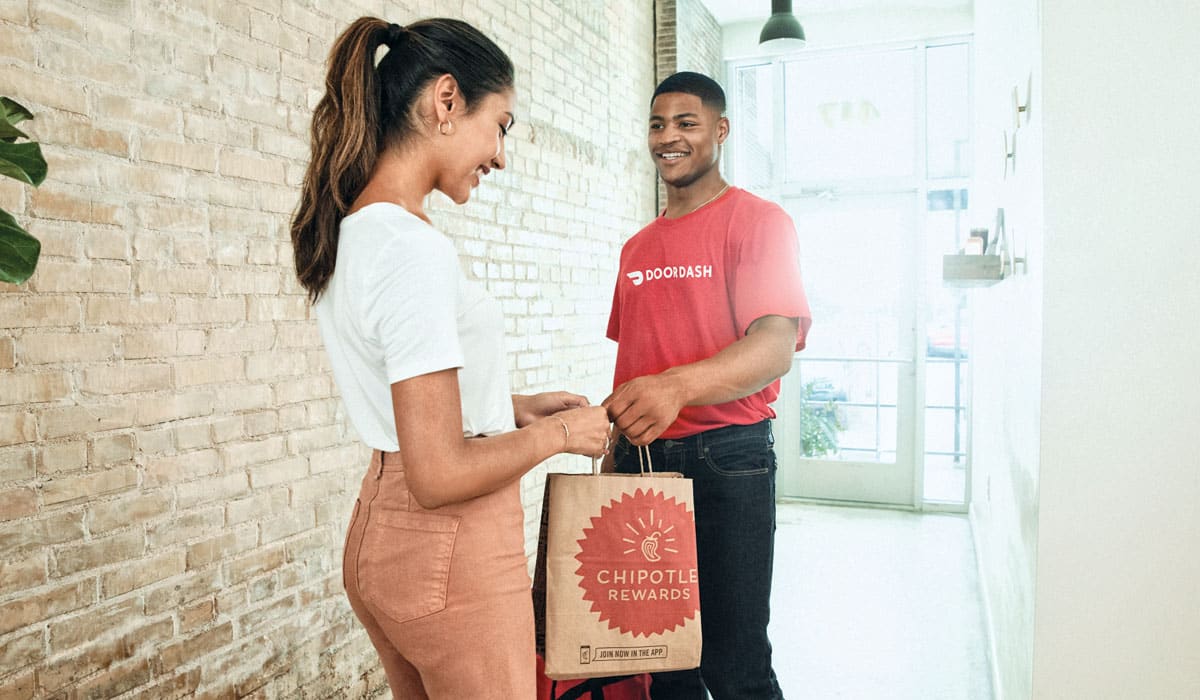Long before a pandemic rocked the industry and forced restaurants across the country to find new ways to provide food to their customers, the term off-premises was already a part of the common industry vernacular. But the pandemic accelerated the trend at a breakneck speed, and those concepts that had already invested in the infrastructure to provide exceptional drive-thru, online ordering, and delivery options had a leg up on the competition.
Chipotle was one of the brands uniquely positioned to thrive in spite of the crisis, having dedicated time, resources, and energy into digitizing its customer experience in recent years. The fast casual has pitched a near perfect game during the crisis, with a commitment to messaging a key part of its pivot. It’s prioritized reminding core customers that they can still get their favorite meals through safe, seamless transactions.
“I like to call our delivery kitchens our superpower because they’ve led to industry-leading pick-up and drop-off times, and helped us create an amazing experience for our guests,” says Tressie Lieberman, Chipotle’s vice president of digital marketing and off-premises. “But at the outset of the pandemic, [there] was messaging we had to execute to create mass awareness around our ability to provide contactless pickup and delivery. That became almost 100 percent of our marketing strategy.”
Portillo’s Hot Dogs, a 62-unit chain based in Chicago, found similar success thanks to a superpower of sorts: its drive-thru window. CEO Michael Onsanloo believes Portillo’s was one of the first brands, pre-COVID, to implement drive-thru runners that greeted customers with an iPad and menus to help get orders to the kitchen quickly. When the pandemic hit and traffic at the drive thru went up 60 percent, the brand sent more runners out to take orders. The results were impressive—Portillo’s barely saw a dip in sales during the spring.
“Even before this, one undeniable trend for fast casuals and quick-service restaurants has been that people want to eat on their own terms,” Osanloo says. “They want to come through a drive thru, or have food delivered to them. What we’re seeing is that if restaurant companies want to be successful, they have to commit to dealing with how to provide off-premises dining in unique ways.”
Other brands found themselves starting from square one, and looked to third-party services to help deliver to customers. Based in Oakland, California, Numa is a startup app with a unique function: It essentially serves as an automated receptionist for customers calling in to ask questions or place orders. The app texts customers and is able to have a conversation with them via artificial intelligence (ai) formed through past consumer experiences. The platform also allows diners to order through AI.
In the pandemic’s early stages, Numa and other third-party ordering and delivery apps proved how important it was to have experts on your side when dealing with something unprecedented. Far easier than building and developing technology as a restaurant was teaming up with tech brands that already had the technology in place. And many of these partner platforms seized the moment when the coronavirus struck by offering their services at a discounted rate or for free.
“One of the approaches we’ve had is to offer our service for free during this crisis,” says Tasso Roumeliotis, founder and CEO of Numa. “What we’ve seen is two-fold: Our existing client base had their orders through our app go up anywhere from four to 10 times their normal volume, and customer uptake has also increased at an alarming rate.”
It was an opportune time to show partner brands what they had been missing had they not already developed convenient ways to provide delivery and curbside pickup options to their customer base.
“Part of our messaging was that we have been living in a curbside economy for some time now,” Roumeliotis says. “If you haven’t been doing curbside pick-up, you need to, but it can also be harrowing and intimidating. So we were telling brands, here is a solution that we can help you get off that ground in less than a day, and if we’re offering it for free, you don’t have to worry about the economics of it. Use it to get through this crisis, and we’ll talk when things start to return to normal.”
Uber Eats received a lot of attention early in the pandemic for its ability to help brands maintain sales and gain clientele, but perhaps less talked about were its efforts to ensure employee and customer safety.
“Across Uber, our focus has been on supporting communities as best as we can during this time of need, and to move what matters,” says Kelly Seeman, director of enterprise sales at Uber Eats. “To those of us at Uber Eats, this means caring for our restaurant partners and delivery people first and foremost. In an effort to help, we drove support to local restaurants with $0 delivery and created an in-app, leave-at-the-door feature.”
The reality is that none of these processes were new a few months ago. But they were suddenly necessary. A complex legacy will be born of the COVID-19 pandemic, a time when many brands floundered and some even went out of business entirely. But, if searching for silver linings, the crisis has also shaped up to be the season when brands and partnering tech companies doubled down on getting resourceful with carryout and delivery. As a result, the off-premises movement was fast-tracked.
“In any business, you have to be flexible, and able to pivot at a moment’s notice,” Chipotle’s Lieberman says. “It’s been inspiring to see that, across the industry, there’s been so much great creativity coming out of this time. … Every business is so different and there’s no one-size-fits-all opportunity. You learn through experimenting, and that’s what a lot of companies out there did, and are doing.”












